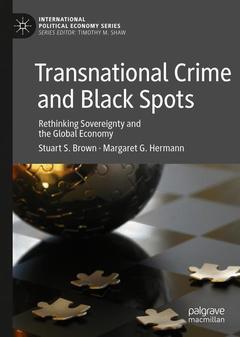Transnational Crime and Black Spots, 1st ed. 2020 Rethinking Sovereignty and the Global Economy International Political Economy Series
Auteurs : Brown Stuart S., Hermann Margaret G.

?The strength of this book is that it does not look at a single case or even a few disparate examples of drug, weapon, and human trafficking but looks at many patterns?intra-regionally, cross-nationally, and internationally. It is an innovative addition to the literature on the nature of the safe havens?or ?black spots??currently being used for illicit activity. This book will make a clear impact on the scholarship of transnational crime and the geopolitics of the illicit global economy.?
?Jeremy Morris, Aarhus University, Denmark
Transnational criminal, insurgent, and terrorist organizations seek places that they can govern and operate from with minimum interference from law enforcement. This book examines 80 such safe havens which function outside effective state-based government control and are sustained by illicit economic activities. Brown and Hermann call these geographic locations ?black spots? because, like black holes in astronomy that defy the lawsof Newtonian physics, they defy the world as defined by the Westphalian state system. The authors map flows of insecurity such as trafficking in drugs, weapons, and people, providing an unusually clear view of the hubs and networks that form as a result. As transnational crime is increasing on the internet, Brown and Hermann also explore if there are places in cyberspace which can be considered black spots. They conclude by elaborating the challenges that black spots pose for law enforcement and both national and international governance.
Chapter 1: Introduction: Setting the Stage.- Part I: Theoretical Foundations.- Chapter 2: Geopolitics and Transnational Crime.- Chapter 3: The New Economic Geography and the Illicit Economy.- Part II: Toward Developing a Black Spots Network.- Chapter 4: Activities, Functions, and Linkages.- Chapter 5: Black Spots, Actors, and Governance.- Chapter 6: Methods of Financing the Illicit Economy.- Part III: Extensions and Implications.- Chapter 7: Black Spots in Cyberspace?.- Chapter 8: Discoveries and Challenges.
Stuart S. Brown is Director of the Master of Arts in International Relations (MAIR) program and Vice-Chair of the Department of Public Administration and International Affairs in the Maxwell School of Syracuse University, USA.
Margaret G. Hermann is Gerald B. and Daphna Cramer Professor of Global Affairs and Director of the Daniel Patrick Moynihan Institute of Global Affairs in the Maxwell School of Syracuse University, USA.
Date de parution : 11-2019
Ouvrage de 250 p.
14.8x21 cm
Thème de Transnational Crime and Black Spots :
Mots-clés :
Transnational Crime; Cyberspace; Illicit Economies; Terrorism; insurgent Organizations; Political Sovereignty; Economic Sovereignty; Law Enforcement; Federally Administered Tribal Areas; Black Spots; Mapping Global Insecurity; Illicit Commerce; The Hakkari-Van Provinces; The Taliban; The International Drug Trade; Trafficked Goods; Trafficked People; Border Security; Money Laundering; Organized Crime; urban politics



